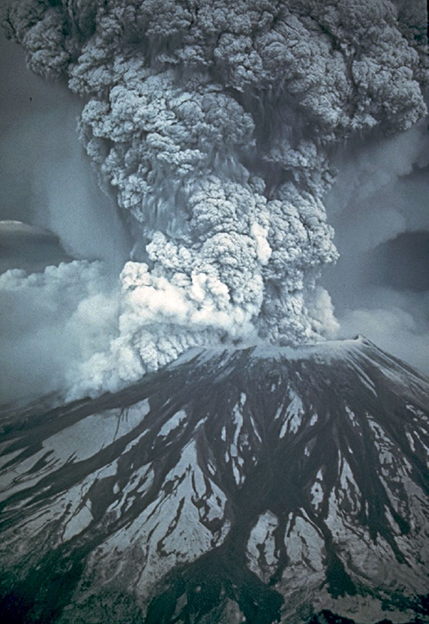1980
Mount St. Helens Eruption
Volcanic island arcs and tall mountain chains are common features on the Earth at tectonic plate boundaries where one plate is sliding under (subducting) the other. Famous examples in the western hemisphere include the Cascade volcanoes in the northwestern US and southwestern Canada.
Volcanoes like those in the Cascades are fundamentally different from the kinds of volcanoes that form at mid-ocean ridges or above intra-plate hotspots, like in the Hawaiian Islands or Iceland. In ridge or hotspot volcanism, magma from the upper mantle erupts relatively gently directly onto the surface, producing relatively fluid lava flows that slowly build up the heights of the ridges or islands. In subduction-zone volcanism, however, melting of the sinking slab of oceanic crust causes melting of the overlying continental crust and thus a lower-iron, higher-silicon, more viscous (thicker) magma. That thicker magma plugs up subsurface fractures and causes gases to build up, until they result in an explosive eruption at the surface that releases huge volumes of pulverized ash and dust.
One of the most dramatic examples in US history of such an explosion occurred on the morning of May 18, 1980, when Mount St. Helens in southern Washington erupted violently. Within minutes, the top fifteen percent of the mountain was blown off, and parts of a thick, roiling cloud of ash some 40 miles (64 kilometers) wide were ejected 15 miles (24 kilometers) high into the stratosphere. Trees, other vegetation, animals, and more than 50 people in a blast zone extending as far as 19 miles (31 kilometers) from the volcano were wiped out, and ashfall up to 5 inches thick settled over parts of Washington, Oregon, and Idaho. The landscape in and around the huge new crater caused by the blast looked more like the surface of the Moon than the Earth.
Fortunately, focused swarms of strong earthquakes in the weeks before the eruption had allowed geologists to predict that an eruption was imminent, and most people in the area evacuated. The mountain has continued to periodically erupt again, however, in smaller events as recently as 2008. Exactly when Mount St. Helens or one of the other Cascade volcanoes will next erupt is unknown, but it is certain that more eruptions will happen along that active plate margin.
SEE ALSO Plate Tectonics (c. 4–3 Billion BCE?), The Sierra Nevada (c. 155 Million BCE), Cascade Volcanoes (c. 30–10 Million BCE), Hawaiian Islands (c. 28 Million BCE), The Andes (c. 10 Million BCE), Pompeii (79), Huaynaputina Eruption (1600), Krakatoa Eruption (1883), Island Arcs (1949), Volcanic Explosivity Index (1982), Mount Pinatubo Eruption (1991), Eyjafjallajökull Eruption (2010)
The violent May 18, 1980 ash and steam eruption of Mount St. Helens, a stratovolcano in southwestern Washington State, USA.
